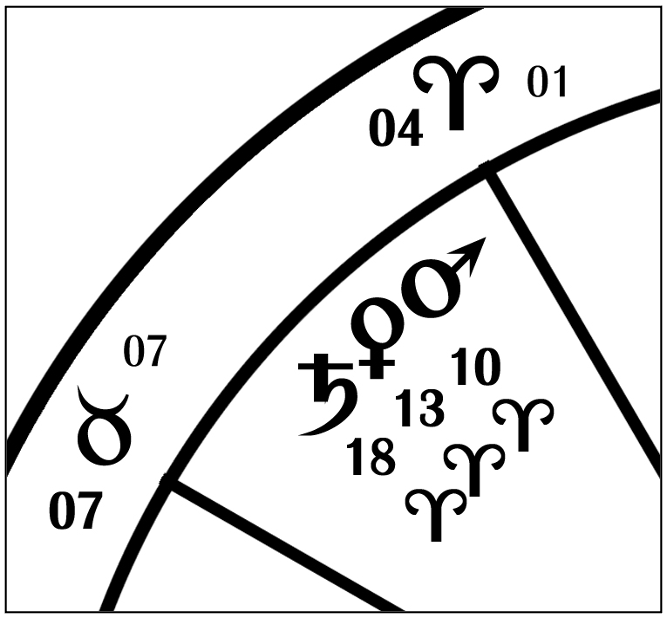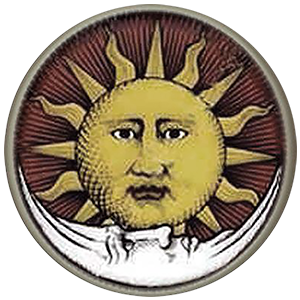Glossary of terms
Special | A | B | C | D | E | F | G | H | I | J | K | L | M | N | O | P | Q | R | S | T | U | V | W | X | Y | Z | ALL
A |
|---|
ApplicationIn a general sense the term 'applying' is used for any
planet moving towards the conjunction or aspect of another. In strict
terminology, a planet is said to be 'in application' or 'applying' to another
when the planets are within orb of aspect and moving towards perfection
(exactness). Planetary motion must be considered, for if a planet is
retrograde an aspect that appears to be applying towards exactness may in fact
be separating, and if a planet is about to turn retrograde an aspect that is
currently in a state of application may fail to perfect. | |
AscendantThe degree of the ecliptic (zodiac) that meets the eastern horizon, and which denotes the 1st house cusp. So called because planets here ascend above the horizon and become visible to the naked eye. | |
Ascension: long and short / direct and crooked
In the northern hemisphere:
signs of long or straight or direct ascension are: Cancer, Leo, Virgo, Libra, Scorpio, Sagittarius
signs of short or crooked ascension are: Capricorn, Aquarius, Pisces, Aries, Taurus, Gemini
Due to the obliquity of the ecliptic, not all signs of the zodiac rise over the ascendant in an even span of time – signs of "long" or "straight" ascension rise at a greater angle to the horizon, which results in longer ascensional times; signs of "short" or "crooked" rise at a more acute angle, so they ascend over the ascendant more quickly. The difference becomes more dramatic the further from the equator the observer is, and the effect is not observed at the equator, where the signs rise at approximately equal times (2hrs per sign). Signs of long ascension are generally associated with longer durations and more direct paths; those of short ascension are associated with shorter durations and more crooked or unclear paths. → This video, set for London, has the Sun near 0° Aries (a sign of short ascension) and the Moon near 0° Libra (sign of long ascension). Note that when the Sun rises (i.e., when Pisces/Aries is rising), the angle the ecliptic makes to the horizon is sharply acute. But by the time the Moon rises (i.e., when Virgo/Libra is rising), the angle the ecliptic makes to the horizon is at its greatest. | |
AspectsThe word 'aspect' comes from the Latin aspicio, 'to regard'. Aspects are measured in celestial longitude and aspect meanings are affected by the geometrical and numerical relationships they make within the zodiacal circle: hence, what is usually called the square aspect today was traditionally called the quadrate or quadrangular aspect (referring to the plane figure that the aspect is able to create) or the tetragonal aspect, referring to the number of sides that its associated geometrical figure possesses (from the Greek tetra, 'four'). The traditionally recognised aspects include: conjunction (0˚), sextile
(60˚), square (90˚), trine (120˚) and opposition (180˚). The easiest way to recognise aspectual relationships is to consider how signs related by a square are all part of the same quadruplicity, and signs related by trine are all part of the same triplicity (as shown in this PDF file).
| |
AstrolabeA mechanical instrument (a forerunner to the sextant), used to determine the altitude of the sun or other celestial bodies. | |
B |
|---|
Barren signsGemini, Leo and Virgo are considered barren and thus not normally conducive to fertility. Aries, Sagittarius and Aquarius are also considered rather barren. In predictive techniques these signs can suggest difficulty in conceiving children, or the prospect of few children, when placed on the 5th cusp of the chart. Most of these signs are considered to have a drying influence. Also known as sterile signs. | |
Below/under the earthDescriptive of planets beneath the horizon, i.e., placed in the 1st, 2nd, 3rd, 4th, 5th or 6th house, (although in the 1st house planets are less affected by this condition since by diurnal rotation they are rising towards the ascendant). When a planet is under the earth it is not visible in the sky; hence, a chart which has a strong theme of planets beneath the earth is descriptive of missing objects that cannot be found, motives that cannot be discovered, illness that are hard to diagnose, facts that cannot be brought to light, and a sense of being buried (as in missing treasure). Contrast with 'Above the earth' | |
Benefic planetsAlso known as ‘fortunes’, these are planets that are judged capable of assisting a positive outcome. Under normal circumstances Jupiter and Venus are considered naturally benefic because of their temperate natures, (Jupiter is traditionally known as the ‘Greater Benefic’ and Venus as the ‘Lesser Benefic’). Many traditional texts also consider the north node to be representative of increase and therefore term it a benefic. Compare with ‘malefic planets’. | |
BesiegementBonatus describes a besieged planet as one that separates from a malefic and applies to another (Con. 6). It shows a situation that is going from bad to worse.
William Lilly described a planet besieged as one that lies between the bodies of the two malefics Mars and Saturn. His example is Mars at 10 ° Aries, Venus 13° Aries, and Saturn 15° Aries. It is generally accepted that besiegement can occur by aspect as well as bodily conjunction. As a principle it refers to a planet trapped by hostile forces on either side.
 The diagram shows William Lilly’s description of Venus besieged between
the bodies of the two malefics: Mars and Saturn (CA, p.114). NB: some older works refer to a contrasting condition - sometimes called 'bonification' or being 'bonified', where a planet is surrounded by contacts with benefic planets. See for example Johanne Schoener's list of scores for dignified and debilitated planets, where a planet surrounded by benefics receives five points, in contrast to a planet surrounded by malefics, which has five points taken away. | |

